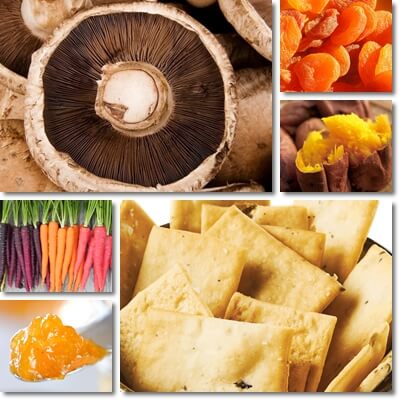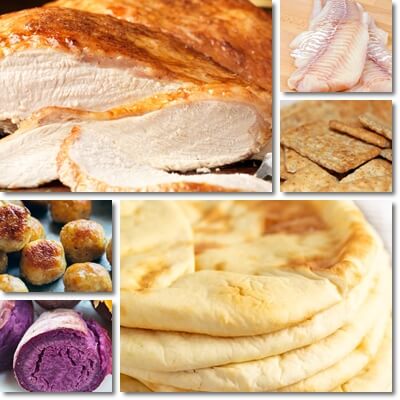What can you eat for lunch for acid reflux? Meals that are both acceptable in an acid reflux diet plan, made from foods that are good to eat in acid reflux disease, or at least safe in the sense that they do not cause excess stomach acidity and heartburn, and that you can actually pack to take with you at work?
As someone who has struggled with acid reflux since very young, I can tell you that there is no such thing as foods that neutralize stomach acid or help cure heartburn. But there are foods that don’t cause excess stomach acid and heartburn which are the so-called foods that are good for acid reflux. Eating them long enough, and avoiding the bad ones, can actually help you erase your acid reflux from existence.

When looking to start your acid reflux diet, it’s good to keep in mind that different people can respond differently to the same foods. Foods like bananas, apples or avocado, whole wheat bread or whole wheat pasta, nuts, seeds and various vegetables, whether it’s tomatoes, spinach, potatoes or zucchini, can be triggers for acid reflux in some people, but good to eat in an acid reflux diet for others.
Generally, some of the worst foods for acid reflux are acidic, fermented, aged, pickled or soured foods, fatty foods, heavily seasoned or spicy foods, and all manner of processed foods from chips to chocolate to candy. But otherwise healthy foods such as broccoli, radishes, ginger, turmeric, avocado, pineapple, tomatoes, bell peppers, cucumbers, beans, beef, dairy milk, salmon or tuna can also be very bad foods for acid reflux.
There are a few golden rules for a successful acid reflux diet:
- Bland foods and skinny foods are some of the best foods you can eat for acid reflux.
- Try and eat right all the time, at least for the first few weeks or, ideally, months of your diet – don’t give into cravings because that can set you back tremendously.
- Eat small portions – this is a great way of making sure that what you do eat doesn’t make your acid reflux worse, even if you haven’t chosen the blandest of foods.
- Stand up after you eat. Try and not lie down for 2-3 hours. Gravity is your best friend if you have acid reflux.
- Know that while some foods are bad for acid reflux in general, that is, most people with the condition experience flareups after eating them. For example, garlic and onions and tomato sauce and paste are common triggers. But there are also foods that are only bad for some people, but good for others. For instance, some people with acid reflux can eat bananas and pineapple and green beans and peas and salmon and fresh, unfermented cheese, while others can’t without experiencing severe digestive upset. Do personalize your acid reflux diet.
See my list of foods to eat and to avoid for acid reflux for more insight on the best and worst foods to eat for the condition.

What can I eat for lunch with acid reflux? (11 Meal ideas for lunch)
1) Cold pasta salad
If you have acid reflux, you can try eating a cold pasta salad made from short pasta such as penne rigate pasta, mini or mezze, farfalle or farfalle tonde pasta, fusilli or fusilly spirale. Boil the pasta as recommended on the package, and pair with grilled zucchini, grilled button or portobello mushrooms, and grilled chicken breast.
You can add a few drops of raw extravirgin olive oil to your pasta to prevent it from sticking, but only a few drops. If you are experiencing digestive upset, then try and avoid the oil and see if there is any improvement. Also, only season with salt and neutral herbs like parsley, fresh or dried. If you have the option to reheat your lunch, you can also puree the zucchini and/or mushrooms to make a sort of a lean pesto-like sauce for your pasta.
For dessert or as a midday snack, you can eat a few boiled baby carrots, 5-6 oil-free banana chips or 5-6 raw almonds or other nuts.
2) Lunch box: chicken or turkey breast and root vegetables, bread
A simple lunch to get you through the day when you have acid reflux can consist of grilled chicken or turkey breast, without skin, season plainly with salt, and some cooked root vegetables. Choose one or two vegetables from the following list: potatoes, sweet potatoes, carrot, parsnip, parsley root, celery root (celeriac), turnip.
Depending on your nutritional requirements and level of physical activity, you can try eating 150-200 grams of chicken or turkey, and 150-200 grams of vegetables. Pair with 2 slices of fresh white flour bread, toasted bread or flatbread such as pita or pitta bread, Indian naan bread, chapati, or Italian piadina flatbread.
3) Lunch box: hard boiled eggs, crackers, baked vegetables
An acceptable acid reflux lunch may consist of 2 hard boiled eggs, 50-70 grams of plain or salted, oil and fat-free dry crackers, and 100-150 grams of vegetables. For vegetables, you can have 1-2 small baked potatoes, half a baked sweet potato, kohlrabi, parsnip or celeriac fries.
To make the faux vegetable fries, cut the root vegetable into strips, boil until more than halfway cooked, then finish in the oven on a baking tray; season simply with salt. Try and see what works best for you from these options, if any. For dessert, you can have 1 small or medium stewed or baked apple, without skin – no lemon juice, no seasoning. You can always eat the cooked apple together with crackers for a quick snack.
4) Quinoa and chicken drumsticks
Prepare 60-80 grams of quinoa by boiling or steaming. Pair with 2-3 small grilled or oven baked chicken drumsticks, seasoned plainly with salt. Grilled and baked chicken drumsticks will taste better for lunch the next day than boiled ones. If your condition allows for it, you can have half a ripe banana for dessert, which you can pair with a few plain crackers.

5) Cous cous with cod fish
Prepare 50-60 grams of cous cous by infusing the grains in hot water for 5-10 minutes. Pair with about 150 grams of boiled, oven baked or roasted cod fish, without skin. Season plainly with salt and very little fresh extravirgin olive oil. For dessert, you can have 2-4 fresh figs, depending on size.
6) Sweet white rice pudding
A lot of people with acid reflux respond well to white rice. A lot can also have small amounts of low fat 1.5% or 1% dairy milk such as cow’s milk, or nut milks or grain milks. If that is you, you can pack a sweet white rice pudding for lunch at work.
The recipe is simple: boil about 50 grams of white rice in plain water until almost completely cooked. You can just add the rice to a pot, add 2 times the amount of water, and boil over medium-low heat until the water is absorbed. After the water is absorbed, taste a few grains.
Add 150 to 200 ml of a milk of your choice, but make sure it’s low fat and without additives, and boil the rice while mixing continuously until most of the milk is incorporated. Turn off the heat, mix in 5 to 10 grams of brown sugar and move the rice to a glass container for the next day’s lunch.
For the toppings you can choose from:
- Raw nuts and seeds, chopped or whole: almonds, walnuts, cashews, pistachios, raw sunflower seeds or pumpkin seeds
- Dried fruit: 2-3 dried apricots
- Stewed fruit, without skin: half an apple, half a quince, half a pear, 1 apricot.
7) Lunch burger
Prepare a hamburger meatball from 100-120 grams of lean ground chicken breast meat, 1 slice of bread or 2 tablespoons of plain breadcrumbs, 1 small whole chicken egg or 1 egg white or 1 egg yolk, salt and some fresh parsley, chopped. Mix everything, form the meatball, and cook in the oven on a baking sheet.
Eat with fresh bread, flatbread or plain hamburger bun made with flour, salt, water and some leavening, if needed, but no oil or other fats, no soured milk, buttermilk, kefir etc. If your condition allows it, you can add 1 medium grilled or baked portobello mushroom to the hamburger, or a few oven baked sweet potato strips.
8) Tortilla wrap with chicken or turkey and vegetables
You need one large unleavened wheat flour tortilla, which you can toast in a pan, and fill with 2 slices of grilled chicken breast or grilled turkey breast, and 50-80 grams of baked or roasted vegetables: potato or sweet potato slices or strips, parsnip, turnip or celeriac, or portobello mushrooms. You can also substitute the chicken and turkey with white crab meat.
9) Potato salad with toasted tortilla wrap chips
For lunch, you can make a potato salad from 200 grams of potato, boiled and chopped, 2 hard boiled chicken eggs, chopped, and half a boiled carrot. Season plainly with salt and, if your condition allows it, a teaspoon of extravirgin olive oil. Eat with 2 medium white flour tortilla wraps which you can break in pieces with your hand and toast in the pan.
Make sure you pack the potato salad separately from the toasted tortilla to keep the latter dry and crunchy. Alternatively, you can have fresh white bread or a flatbread of your choice (e.g. pita or pitta bread, naan bread, chapati or roti Indian bread), even dry crackers.
10) Tortilla wrap with baked omelet
In an oven safe dish, bake your omelet – it can be 2-3 whole regular chicken eggs, or a egg white omelet made from 100-150 grams of egg white, all seasoned plainly with salt. Fill up 1-2 tortilla wraps with the omelet and 1-2 types of vegetables. Choose from grilled portobello mushrooms, baked root vegetable slices or strips (carrots, potato, sweet potato, celeriac, parsnip).
Alternatively, you can incorporate 50 grams of frozen spinach, boiled, or 100 grams of fresh spinach leaves into your omelet before cooking it. If you whish or beat the egg whites with a mixer to make them fluffy, you also have the option to bake them on a baking sheet, or incorporate 2 tablespoons of white flour for a more particular recipe.
11) Soft boiled eggs lunch box
Soft boiled eggs taste good cold too and you can pack them in your lunch box. Pair with 2-3 slices of chicken breast or turkey breast cold cuts – choose low-fat, low-sodium options with few to no additives. Eat with flour or maize tortilla, either as they are or toasted in a pan, or flatbread. You can have 1 medium portobello mushroom, grilled, one medium baked potato, or half a sweet potato, baked.
